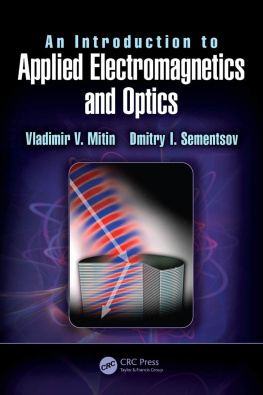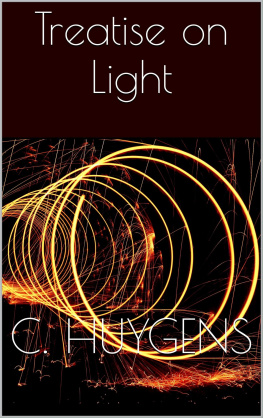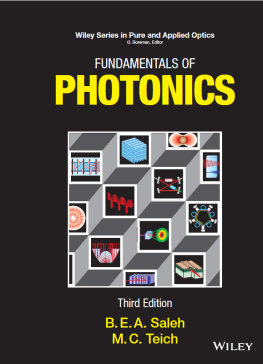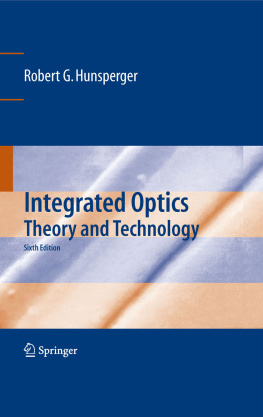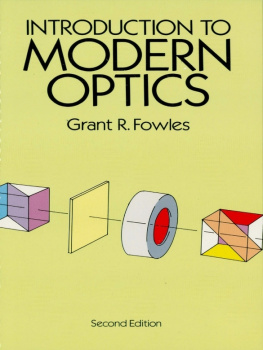An Introduction to Applied
Electromagnetics and Optics
An Introduction to Applied
Electromagnetics and Optics
Vladimir V. Mitin Dmitry I. Sementsov
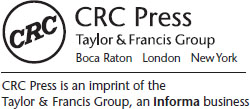
CRC Press
Taylor & Francis Group
6000 Broken Sound Parkway NW, Suite 300
Boca Raton, FL 33487-2742
2017 by Taylor & Francis Group, LLC
CRC Press is an imprint of Taylor & Francis Group, an Informa business
No claim to original U.S. Government works
Printed on acid-free paper
Version Date: 20160908
International Standard Book Number-13: 978-1-4987-7629-5 (Hardback)
This book contains information obtained from authentic and highly regarded sources. Reasonable efforts have been made to publish reliable data and information, but the author and publisher cannot assume responsibility for the validity of all materials or the consequences of their use. The authors and publishers have attempted to trace the copyright holders of all material reproduced in this publication and apologize to copyright holders if permission to publish in this form has not been obtained. If any copyright material has not been acknowledged please write and let us know so we may rectify in any future reprint.
Except as permitted under U.S. Copyright Law, no part of this book may be reprinted, reproduced, transmitted, or utilized in any form by any electronic, mechanical, or other means, now known or hereafter invented, including photocopying, microfilming, and recording, or in any information storage or retrieval system, without written permission from the publishers.
For permission to photocopy or use material electronically from this work, please access www.copyright.com (http://www.copyright.com/) or contact the Copyright Clearance Center, Inc. (CCC), 222 Rosewood Drive, Danvers, MA 01923, 978-750-8400. CCC is a not-for-profit organization that provides licenses and registration for a variety of users. For organizations that have been granted a photocopy license by the CCC, a separate system of payment has been arranged.
Trademark Notice: Product or corporate names may be trademarks or registered trademarks, and are used only for identification and explanation without intent to infringe.
Visit the Taylor & Francis Web site at
http://www.taylorandfrancis.com
and the CRC Press Web site at
http://www.crcpress.com
Contents
Modern technology is developing rapidly, and for this reason, future engineers need to acquire advanced knowledge in science and technology that includes advanced knowledge of electromagnetic phenomena. Hence, we have developed a course in applied electromagnetics that resulted in this book. In contrast to the conventional texts on electromagnetics, substantial attention is paid to the optical part of the electromagnetic spectrum and to electromagnetic waves in different media and structures. Each topic has solved examples. Problems at the end of each chapter are supplemented by either hints or answers to help students to master the material and to solve typical problems of electromagnetics and optics.
The book consists of four sections. from their physics courses taken previously. If students are well prepared by these prerequisite courses, an instructor can review this section very fast.
, Electromagnetic Waves in Homogeneous Media without Absorption, covers the basic equations describing electromagnetic waves in a homogeneous, isotropic, nonabsorbing medium, as well as the basic properties of these waves.
, Electromagnetic Fields and Waves at the Interface between Two Media, discusses the amplitude and energy, reflection, and transmission coefficients of an electromagnetic wave at an interface, the laws of reflection and refraction, total internal reflection, and reflection from a dielectric layer.
, Electromagnetic Waves in Anisotropic and Optically Active Media, is devoted to topics that are rarely discussed in the previous studies. An anisotropic medium is one in which physical properties vary along different directions. In an anisotropic medium, there are specific directions (or a direction known as the axis of symmetry) that are associated with the structure of the medium or with an external electric and/or magnetic field. Anisotropy of a medium leads to the fact that the magnitude of a wave vector, the group and phase velocity of the wave, and its polarization parameters depend not only on the frequency but also on the direction of the wave propagation with respect to the axis of symmetry.
, Electromagnetic Waves in Conducting Media, covers dielectric permittivity and impedance of metals, skin effect, and surface waves at the interface between a dielectric and a conductor. An electromagnetic wave propagating through a conducting medium loses some of its energy that is transformed predominantly into the thermal energy of that material. Superconductivity is also discussed as an example of a conducting medium without losses.
, Waves in Periodic Structures, covers in detail diffraction phenomena such as diffraction by a slit, by a 1D lattice, and by a 3D lattice. Special attention is paid to an often omitted topic: waves in periodic structures (photonic crystals). Forbidden photonic bands in the reflection and transmission spectra are formed for a wave propagating in the periodic medium along a periodicity axis.
, Waves in Guiding Structures, in addition to the conventional waveguides (two parallel metal planes, a rectangular waveguide, and two-wire, coaxial, and stripline transmission lines), this chapter also covers optical waveguides (optical fibers).
, Emission of Electromagnetic Waves, is devoted to emission by accelerated charges, by an electric dipole (Hertz antenna), and by an elementary magnetic dipole. Directional diagrams of different sources of electromagnetic radiation and types of antennas are also discussed. Students are introduced to the near-field zone that extends from a source to distances that have the same order of magnitude with the wavelength of the electromagnetic wave generated by the source and to the far-field zone that is located at a distance much greater than the wavelength of the emitted wave.
), Advanced Topics in Electromagnetics and Optics, introduces students to recent advances in the field of electromagnetics and optics. In particular:
, Electromagnetic Waves in Gyrotropic Media, discusses the electromagnetic waves in gyrotropic media, magnetoactive plasma, and ferrites. Such media have the ability to rotate the polarization plane of linearly polarized electromagnetic waves, which propagate through them. The properties of the media are controlled by an external magnetic field.
, Electromagnetic Waves in Amplyifying Media, addresses the media that can amplify optical radiation. Amplification of waves in a medium is due to the induced radiation emitted by the excited atoms of the medium. The basic principles of amplification are discussed and students are introduced to lasers where amplification occurs due to the induced coherent emission by excited atoms under the influence of the electromagnetic wave field.
, Electromagnetic Waves in Media with Material Parameters That Are Complex Numbers, is devoted to a detailed discussion of wave propagation in media for which the relative dielectric permittivity or the relative magnetic permeability (or both) is a complex number with a nonzero imaginary part. Electromagnetic tunneling and negative refraction in media with negative permittivity and permeability are also discussed.
As it has been shortly presented earlier, the book covers both conventional material and material that is very rarely discussed in undergraduate textbooks, such as superconductors, surface waves, plasmas, photonic crystals, and negative refraction.
Next page
